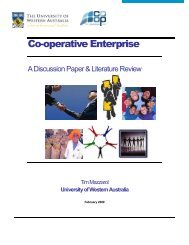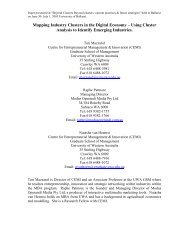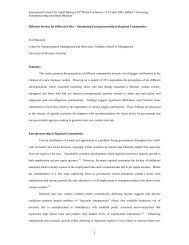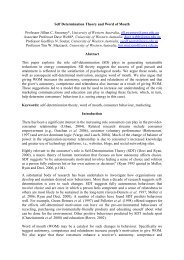The Third Wave: Future Trends in International Education - CEMI
The Third Wave: Future Trends in International Education - CEMI
The Third Wave: Future Trends in International Education - CEMI
You also want an ePaper? Increase the reach of your titles
YUMPU automatically turns print PDFs into web optimized ePapers that Google loves.
Centre for Entrepreneurial Management and Innovation<br />
<strong>The</strong> <strong>Third</strong> <strong>Wave</strong>: <strong>Future</strong> <strong>Trends</strong> <strong>in</strong> <strong>International</strong> <strong>Education</strong><br />
7<br />
of students study<strong>in</strong>g overseas was becom<strong>in</strong>g a serious dra<strong>in</strong> on the economy. In 1997, there were nearly<br />
35,000 Malaysians study<strong>in</strong>g overseas, of which around one third were <strong>in</strong> Australia (UNESCO 1997). With only a<br />
small higher education sector, Malaysia had encouraged the development of tw<strong>in</strong>n<strong>in</strong>g-college agreements<br />
dur<strong>in</strong>g the late 1980s and early 1990s. By 2000 there were around 120 private colleges offer<strong>in</strong>g tw<strong>in</strong>n<strong>in</strong>g<br />
programs and 30 with ‘3+0’ programs <strong>in</strong> which all teach<strong>in</strong>g was undertaken <strong>in</strong> Malaysia (M<strong>in</strong>istry of <strong>Education</strong><br />
Malaysia 2001). Although these ‘second wave’ programs helped to alleviate some of the country’s supply-side<br />
problems, there were concerns emerg<strong>in</strong>g over the quality and commercial focus of these programs. <strong>The</strong><br />
government policy response was the <strong>Education</strong> Act (1998) enabl<strong>in</strong>g foreign universities to establish branch<br />
campuses. Australia’s Monash University and Curt<strong>in</strong> University of Technology, and the UK’s University of<br />
Nott<strong>in</strong>gham reacted quickly to this policy change establish<strong>in</strong>g branch campuses <strong>in</strong> Malaysia by the end of the<br />
century.<br />
Malaysia and S<strong>in</strong>gapore also appear motivated by the desire to compete actively <strong>in</strong> the Asia-Pacific region with<br />
exist<strong>in</strong>g education supplier nations such as Australia, Canada and New Zealand. <strong>The</strong> f<strong>in</strong>ancial benefits of<br />
play<strong>in</strong>g host to large numbers of fee-pay<strong>in</strong>g <strong>in</strong>ternational students have been well demonstrated by such<br />
established players. It is therefore not surpris<strong>in</strong>g that new entrants to this lucrative <strong>in</strong>ternational <strong>in</strong>dustry<br />
should emerge. Demand for education services with<strong>in</strong> the Asia-Pacific region is forecast to grow strongly over<br />
the course of the 21 st Century (Blight 1995). Despite the economic slowdown of 1997 <strong>in</strong>ternational student<br />
enrolments <strong>in</strong> Malaysia-based <strong>in</strong>stitutions have <strong>in</strong>creased steadily from a mere 5,635 <strong>in</strong> 1996 to 26,649 <strong>in</strong> 2000<br />
(M<strong>in</strong>istry of <strong>Education</strong> Malaysia 2001). Such students were be<strong>in</strong>g drawn from over 134 different countries.<br />
While these ‘third wave’ branch campuses represent m<strong>in</strong>ority players <strong>in</strong> the overall Malaysian education<br />
sector at time of writ<strong>in</strong>g, the outlook for them to grow over the next 5 to 10 years is significant. Much of this is<br />
likely to be driven by the superior quality of their programs and facilities. However, these campuses also have<br />
the strong back<strong>in</strong>g of state and federal government agencies. For example, Curt<strong>in</strong> University’s campus at Miri<br />
<strong>in</strong> the state of Sarawak was <strong>in</strong>itiated by a group of private stakeholders, but later supported by the Deputy<br />
Chief M<strong>in</strong>ister of State. This has become someth<strong>in</strong>g of a ‘pet’ project for the Sarawak Government who have<br />
plans to expand the campus to around 10,000 students by 2010. <strong>The</strong> Curt<strong>in</strong> campus project is understood to<br />
have received a grant of RM500 million to assist with its development over the next ten years. <strong>The</strong> University<br />
of Nott<strong>in</strong>gham branch campus <strong>in</strong> Malaysia has received strong support from the Malaysian M<strong>in</strong>ister for<br />
<strong>Education</strong> who has personal l<strong>in</strong>ks to that British <strong>in</strong>stitution, and Monash University’s branch campus <strong>in</strong> Kuala<br />
Lumpur has the back<strong>in</strong>g of a prom<strong>in</strong>ent group of Malaysian politicians.<br />
All ‘third wave’ branch campuses <strong>in</strong> Malaysia have multiple stakeholders. <strong>The</strong> government and its agencies<br />
usually provide land and some f<strong>in</strong>ancial support to assist <strong>in</strong> the <strong>in</strong>itial start-up of the facility. Closely associated<br />
with this are local private <strong>in</strong>vestors. <strong>The</strong> foreign university partner is the other key stakeholder that usually<br />
provides its <strong>in</strong>tellectual property, ‘brand name’ and human capital. <strong>The</strong> pr<strong>in</strong>cipal obstacle to the expansion of<br />
branch campuses <strong>in</strong> Malaysia is likely to be potential squabbl<strong>in</strong>g or rivalry between various <strong>in</strong>fluential<br />
stakeholders seek<strong>in</strong>g to encourage the development of their own alliance partner. For example, while the Miri<br />
campus of Curt<strong>in</strong> University has received strong support from the Sarawak State Government, some rivalry has<br />
emerged with the Sarawak Sw<strong>in</strong>burne Institute of Technology located <strong>in</strong> Kuch<strong>in</strong>g. Backed by the f<strong>in</strong>ancially<br />
powerful Sarawak Foundation (which has been a major stakeholder <strong>in</strong> the Curt<strong>in</strong> project), the Sw<strong>in</strong>burne<br />
campus has received government support <strong>in</strong> the form of around 300 student scholarships <strong>in</strong> 2000, and a<br />
lakeside location for its campus adjacent to the Sarawak State Library. It is understood that the Sw<strong>in</strong>burne<br />
campus is to seek university status by 2002 with projections of up to 15,000 students by 2005.<br />
While these Malaysian-based branch campus projects appear to have strong local government support they<br />
will still require a substantial period of time to fully develop and become f<strong>in</strong>ancially viable. Unlike tw<strong>in</strong>n<strong>in</strong>g<br />
programs, these branch campuses are not viewed as be<strong>in</strong>g primarily commercial <strong>in</strong> nature. <strong>The</strong> participat<strong>in</strong>g<br />
Centre for Entrepreneurial Management and Innovation | www.cemi.com.au
















